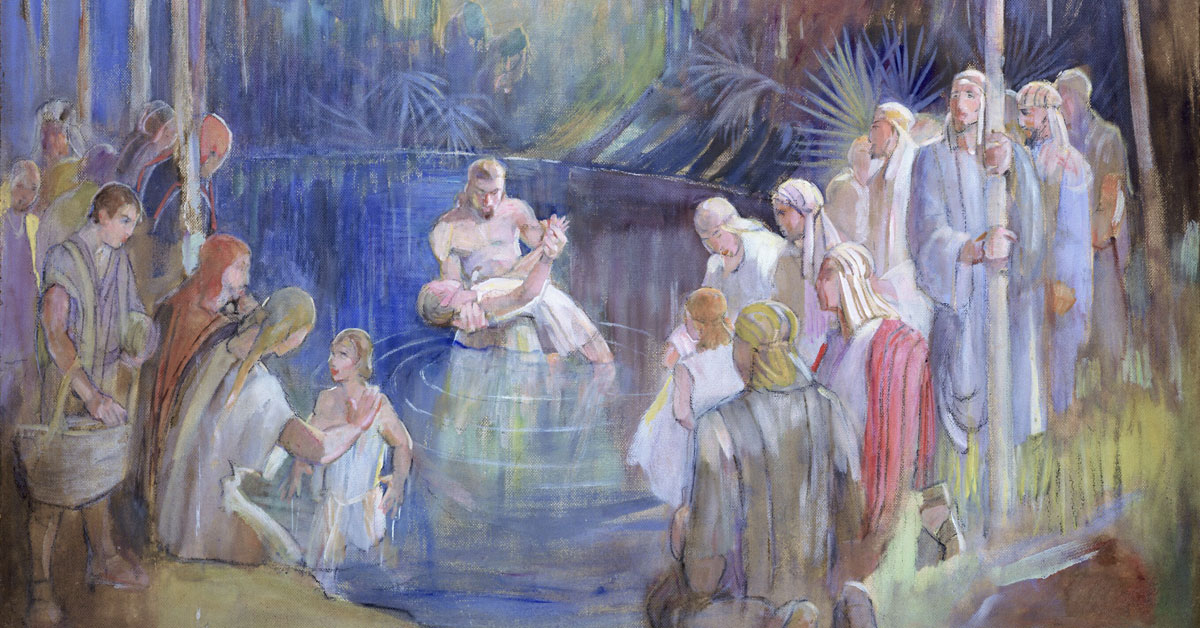You are here
Book of Mormon Central is in the process of migrating to our new Scripture Central website.
We ask for your patience during this transition. Over the coming weeks, all pages of bookofmormoncentral.org will be redirected to their corresponding page on scripturecentral.org, resulting in minimal disruption.

Scripture Block
Moroni 1–6
November 30–December 6. “To Keep Them in the Right Way”
Recommended Resources
Learn about the Book of Mormon with verse by verse commentaries from renowned Book of Mormon scholars like John W. Welch and Brant A. Gardner in the ScripturePlus app. Read this week's KnoWhy connected with the Come Follow Me curriculum, and watch a video elucidating an insight in this week's scripture reading.
KnoWhys
Reading Plan
Structure your personal scripture study by following a multimedia, day by day plan. Each day's assignment includes the required scripture passages from the Come Follow Me curriculum, as well as suggestions for additional resources to bring context and understanding to your study.
Monday
- Quote: “Moroni,” Encyclopedia of Mormonism
Tuesday
- Scripture: Moroni 1:1-4
-
Quote: "Religion and warfare were closely connected in the Book of Mormon. Certain elements of the Israelite patterns of 'holy war' were continued in the Book of Mormon, such as the important ancient idea that success in war was due fundamentally to the will of God and the righteousness of the people."
Hamblin, William J. “Book of Mormon, History of Warfare In.” In Encyclopedia of Mormonism, 163. New York: Macmillan, 1992. -
Quote: “It was so with the other prophets of the Old Testament. The burden of their message was a denunciation of wickedness. And the peril of those times was not peculiar to the Old World. The Book of Mormon documents that in the Western Hemisphere the armies of the Jaredites fought to the death. The Nephites and the Lamanites also fought until thousands had died and Moroni was forced to wander alone for the safety of his own life. His great and final plea, directed toward those of our day, was a call to righteousness.”
Hinckley, Gordon B. “The Dawning of a Brighter Day,” General Conference April 2004. -
Quote: “After so much was already written, and with so little space left on the plates, why would Moroni write about ordinances? What is so important about ordinances? Few of his own people remained, so he was writing to us, in the last days. Moroni knew that there would be a host of churches at the end of time that placed little or no value on ordinances. But as God has clearly taught, 'in the ordinances [of the gospel], the power of godliness is manifest. And without the ordinances thereof, and the authority of the priesthood, the power of godliness is not manifest unto men in the flesh.' At the heart of our quest to obtain the power of godliness are the ordinances. The holy ordinances received only in the holy place can make us a holy people, even like God, as we keep them.”
Ogden, D. Kelly, and Andrew C. Skinner. Verse by Verse: The Book of Mormon. 2:289-290. Salt Lake City, UT: Deseret Book, 2011.
Wednesday
- Scripture: Moroni 2:1-3
-
Quote: “While in every instance the Nephite twelve are spoken of as disciples, the fact remains that they had been endowed with divine authority to be special witnesses for Christ among their own people. Therefore, they were virtually apostles to the Nephite race, although their jurisdiction was, as revealed to Nephi, eventually to be subject to the authority and jurisdiction of Peter and the twelve chosen in Palestine (see Mormon 3:18-19). According to the definition prevailing in the world an apostle is a witness for Christ, or one who evangelizes a certain nation or people. . . .Therefore the Nephite twelve became apostles, as special witnesses, just as did Joseph Smith and Oliver Cowdery in the Dispensation of the Fulness of Times.”
Smith, Joseph Fielding. Answers to Gospel Questions. 1:122. Salt Lake City, UT: Deseret Book, 1960. - KnoWhy 249: Why Did Moroni Keep Writing?
Thursday
- Scripture: Moroni 3:1-4
-
Quote: “President Joseph Fielding Smith taught, ‘When the Savior came to the Nephites, he established the Church in its fulness among them, and he informed them that former things had passed away, for they were all fulfilled in him. He gave the Nephites all the authority of the priesthood which we exercise today. Therefore we are justified in the belief that not only was the fulness of the Melchizedek Priesthood conferred, but also the Aaronic, just as we have it in the Church today; and this Aaronic Priesthood remained with them from this time until, through wickedness, all priesthood ceased. We may be assured that in the days of Moroni the Nephites did ordain teachers and priests in the Aaronic Priesthood; but before the visit of the Savior they officiated in the Melchizedek Priesthood.’”
McConkie, Joseph Fielding, and Robert L. Millet. Doctrinal Commentary on the Book of Mormon. 4:323–324. Salt Lake City, UT: Deseret Book, 2007.
Friday
- Scripture: Moroni 4:1-3
- KnoWhy 250: Where did Moroni Get the Sacramental Prayers from?
Saturday
- Scripture: Moroni 5:1-2
-
Quote: “The Lord revealed to Joseph Smith that ‘it mattereth not what ye shall eat or what ye shall drink when ye partake of the sacrament, if it so be that ye do it with an eye single to my glory—remembering unto the Father my body which was laid down for you, and my blood which was shed for the remission of your sins...’ It took a number of years before the congregations of the Saints totally abolished the use of wine in the sacrament, but by the end of President Brigham Young’s administration, the use of water for the sacrament was generally the practice.”
Haight, David B. “Remembering the Savior’s Atonement.” Ensign, April 1988, 11. -
Quote: “[A]t the conclusion of Benjamin’s speech, his people entered into a covenant, saying ‘we are willing . . . to be obedient to [God’s] commandments in all things that he shall command us,’ after which they agreed to ‘take upon [themselves] the name of Christ’ and obligated themselves to ‘remember to retain the name written always in [their] hearts’ (Mosiah 5:5-12). These three specific promises not only reappear in Moroni 4, but are still the essential elements of the sacramental prayers as they are used today.”
Welch, John W. “Our Nephite Sacrament Prayers.” In Reexploring the Book of Mormon, edited by John W. Welch, 286. Salt Lake City, UT: Deseret Book, 1992.
Sunday
- Scripture: Moroni 6:1-9
- KnoWhy 450: What Can an Ancient Christian Text Tell us About the Book of Mormon?
- KnoWhy 251: Why Was Singing Hymns a Part of Nephite Worship Services?
Additional Resources (Bibliography)
Moroni
Peterson, H. Donl. “Moroni, the Last of the Nephite Prophets.” In The Book of Mormon: Fourth Nephi Through Moroni, From Zion to Destruction, edited by Monte S. Nyman and Charles D. Tate, Jr., 235–249. Provo, UT: Religious Studies Center, Brigham Young University, 1995.
Sperry, Sidney B. “What the Book of Mormon Is (Concluded).” Journal of Book of Mormon Studies 4, no. 1 (1995): 28–40.
Sperry, Sidney B. “Moroni the Lonely: The Story of the Writing of the Title Page to the Book of Mormon.” Journal of Book of Mormon Studies 4, no. 1 (1995): 255–259.
Thomas, Mark D. “Moroni: The Final Voice.” Journal of Book of Mormon Studies 12, no. 1 (2003): 88–99, 119-120.
Moroni 1
Hatch, Gary Layne. “Mormon and Moroni: Father and Son.” In The Book of Mormon: Fourth Nephi Through Moroni, From Zion to Destruction, edited by Monte S. Nyman and Charles D. Tate, Jr., 105–115. Provo, UT: Religious Studies Center, Brigham Young University, 1995.
Moroni 2
Gee, John. “Quotations of the Sealed Portions of the Book of Mormon.” Insight: A Window on the Ancient World 24, no. 6 (2004): 2–3.
Welch, John W. “From Presence to Practice: Jesus, the Sacrament Prayers, the Priesthood, and Church Discipline in 3 Nephi 18 and Moroni 2–6.” Journal of Book of Mormon Studies 5, no. 1 (1996): 119–139.
Moroni 2:3
Book of Mormon Central. “Why Did Moroni Keep Writing? (Moroni 2:3).” KnoWhy 249 (December 9, 2016).
Moroni 3
Welch, John W. “From Presence to Practice: Jesus, the Sacrament Prayers, the Priesthood, and Church Discipline in 3 Nephi 18 and Moroni 2–6.” Journal of Book of Mormon Studies 5, no. 1 (1996): 119–139.
Moroni 4
Anderson, Richard Lloyd. “Religious Validity: The Sacrament Covenant in Third Nephi.” In By Study and Also By Faith: Essays in Honor of Hugh W. Nibley, Vol. 2. Edited by John M. Lundquist and Stephen D. Ricks. Provo, U: FARMs, 1990.
Book of Mormon Central. “Where did Moroni Get the Sacramental Prayers from? (Moroni 4:1).” KnoWhy 250 (December 12, 2016).
Nicholson, John. “Questions and Answers - On Administering the Sacrament.” Improvement Era 5, no. 6 (1902): 473–474.
Pixton, Paul B., and John S. Tanner. “Sacrament.” In Encyclopedia of Mormonism. Edited by Daniel H. Ludlow. Vol. 3. New York: Macmillan, 1992.
Tanner, John S. “Reflections on the Sacrament Prayers.” Ensign 16 (Apr. 1986):7–11.
Welch, John W., and Greg Welch. “Book of Mormon Covenant Language.” In Charting the Book of Mormon: Visual Aids for Personal Study and Teaching. Provo, UT: Foundation for Ancient Research and Mormon Studies, 1999, chart 58.
Welch, John W. “Benjamin’s Covenant as a Precursor of the Sacrament Prayers.” In King Benjamin’s Speech: “That Ye May Learn Wisdom.” Edited by John W. Welch and Stephen D. Ricks, 295–314. Provo, UT: FARMS, 1998.
Welch, John W. “From Presence to Practice: Jesus, the Sacrament Prayers, the Priesthood, and Church Discipline in 3 Nephi 18 and Moroni 2–6.” Journal of Book of Mormon Studies 5, no. 1 (1996): 119–139.
Welch, John W. “Our Nephite Sacrament Prayers.” In Reexploring the Book of Mormon, edited by John W. Welch, 286–289. Provo, UT/Salt Lake City: FARMS/Deseret Book, 1992.
Moroni 5
Anderson, Richard Lloyd. “Religious Validity: The Sacrament Covenant in Third Nephi.” In By Study and Also By Faith: Essays in Honor of Hugh W. Nibley, Vol. 2. Edited by John M. Lundquist and Stephen D. Ricks. Provo, U: FARMs, 1990.
Pixton, Paul B., and John S. Tanner. “Sacrament.” In Encyclopedia of Mormonism. Edited by Daniel H. Ludlow. Vol. 3. New York: Macmillan, 1992.
Tanner, John S. “Reflections on the Sacrament Prayers.” Ensign 16 (Apr. 1986):7–11.
Welch, John W., and Greg Welch. “Book of Mormon Covenant Language.” In Charting the Book of Mormon: Visual Aids for Personal Study and Teaching. Provo, UT: Foundation for Ancient Research and Mormon Studies, 1999, chart 58.
Welch, John W. “Benjamin’s Covenant as a Precursor of the Sacrament Prayers.” In King Benjamin’s Speech: “That Ye May Learn Wisdom.” Edited by John W. Welch and Stephen D. Ricks, 295–314. Provo, UT: FARMS, 1998.
Welch, John W. “From Presence to Practice: Jesus, the Sacrament Prayers, the Priesthood, and Church Discipline in 3 Nephi 18 and Moroni 2–6.” Journal of Book of Mormon Studies 5, no. 1 (1996): 119–139.
Welch, John W. “Our Nephite Sacrament Prayers.” In Reexploring the Book of Mormon, edited by John W. Welch, 286–289. Provo, UT/Salt Lake City: FARMS/Deseret Book, 1992.
Moroni 6
Woodford, Robert J. “The Articles and Covenants of the Church of Christ and the Book of Mormon.” In Sperry Symposium Classics: The Doctrine and Covenants. Edited by Craig K. Manscill. Provo, UT: Religious Studies Center, Brigham Young University, 2004, 103–116.
Moroni 6:5
Book of Mormon Central. “What Can an Ancient Christian Text Tell us About the Book of Mormon? (Moroni 6:5).” KnoWhy 450 (July 17, 2018).
Moroni 6:9
Book of Mormon Central. “Is the Book of Mormon Musical? (Ether 6:9).” KnoWhy 500 (January 31, 2019).




